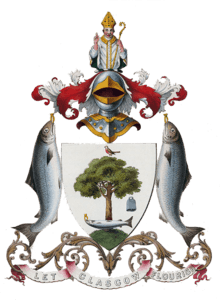Sauchiehall Street
 Sauchiehall Street looking eastwards from carpark location | |
| Type | Commercial/Transport |
|---|---|
| Maintained by |
Glasgow City Council Transport Scotland |
| Length | 2.5 km (1.6 mi) |
| Location | Glasgow |
| Postal code | G1 |
| Nearest Glasgow Subway station | Buchanan Street subway station |
| Other | |
| Known for | ABC Glasgow, Glasgow School of Art, Glasgow Film Theatre, |
Sauchiehall Street (/ˌsɔːkɪˈhɔːl,
Although commonly associated with the city centre, Sauchiehall street is over 11⁄2 miles (2.5 km) long, finally meeting Argyle Street in the West End, in front of the Kelvingrove Museum, where they merge to form Dumbarton Road, continuing through Partick. The two streets run parallel through the city centre, before starting to conjoin westward of the M8 motorway at Charing Cross.
Name
Sauchiehall is a corruption of the Scots sauchie hauch, sauchie; abounding in willows and hauch; a low-lying meadow by the side of a river (compare Sausalito, California). Hauch is pronounced 'haw' in Scots and was mistaken for the Scots haw, pronounced the same, meaning hall.[3]
History

Sauchiehall Street is one of the most famous streets in Glasgow, partly due to its rich history. The desire of wealthy merchants to own property on the outskirts of the city meant that it was expanded and as a result of this Sauchiehall Street grew. Around 1820 the street was known as Saughie-haugh road, a quiet narrow road with a number of villas and terraces with distinguished names. After the street was widened in 1846, older buildings were replaced with tenements in the 1850s and then some commercial buildings in the 1870s, yet a few of the original villas still remained as of 1896 according to the Ordnance Survey map of Central Glasgow. [4]
Over time, the street has been home to a number of notable buildings. This includes the Glasgow Empire Theatre which was opened in 1897 at 31–35 Sauchiehall Street. The Theatre played host to big names such as Bob Hope, Frank Sinatra, Judy Garland, Dorothy Lamour, Jack Benny and Danny Kaye before it closed on 31 March 1963. The Royalty Theatre was also situated on Sauchiehall Street, opening in 1879 and showing operas, comedies and plays up until its lease ran out in 1913. Afterwards, during the First World War, it was purchased by the YMCA to become a hostel for soldiers and sailors. The building lived out the rest of its days after the war as the Lyric Theatre, before it was demolished in the late 1950s.[5]
Glasgow's first "skyscraper", the Art Deco style Beresford Hotel, was built further along Sauchiehall Street in 1938 for the Empire Exhibition. It is now a Hall of Residence for Strathclyde University. Its "modern" architecture was disliked when it was built and the original mustard-coloured stonework with red fins was rather unkindly described as "custard and rhubarb architecture". [6]
In 2014 Sauchiehall Street was the subject of the documentary TV series 'The Street'.[7]
City centre section

Sauchiehall Street formerly linked directly to Parliamentary Road at its eastern end, which continued through Townhead to the Glasgow Royal Infirmary. Today at the eastern end of Sauchiehall Street is the Glasgow Royal Concert Hall and Buchanan Galleries, one of the largest city centre redevelopments in the UK.[8]
The section from West Nile Street to Rose Street was originally pedestrianised in 1972, with the easternmost part, linking to Buchanan Street, pedestrianised in 1978. This part of the street consists primarily of typical High Street retailers, although it also includes the Willow Tearooms, designed in 1903 by Charles Rennie Mackintosh, which has been restored to its original artistic designs and is still open to the public as a tea room.[9]
Clubs and museums
At the western end of the city centre section of the street, towards Charing Cross, there is an abundance of restaurants, bars and student-oriented clubs, such as the ABC, a former cinema[10] and the largest nightclub in Glasgow, The Garage (night club). This is a very popular street in terms of Glasgow nightlife. Notable landmarks in this area of the street include the former Beresford Hotel, Glasgow School of Art, the Glasgow Film Theatre, CCA Glasgow, the McLellan Galleries, the Royal Highland Fusiliers Museum and the Glasgow Dental Hospital and School.[11]
Notable residents
Murderer Edward William Pritchard, the last person to be publicly hanged in Glasgow.[12]
References
- ↑ Jones, Daniel (2011). Roach, Peter; Setter, Jane; Esling, John, eds. Cambridge English Pronouncing Dictionary (18th ed.). Cambridge University Press. ISBN 978-052-115255-6.
- ↑ SeeGlasgow.com Archived 27 September 2008 at the Wayback Machine.
- ↑ "How Glasgow's famous landmarks got their names". INews. 27 June 2017. Retrieved 15 June 2018.
- ↑ "Sauchiehall Street, Glasgow". Glasgow History. Retrieved 2018-06-15.
- ↑ "Lyric and Empire Theatres Glasgow". Moving Image. Retrieved 15 June 2018.
- ↑ "Did You Know? - Sauchiehall Street". Rampantscotland.com. Retrieved 2018-06-15.
- ↑ TV: a Tube with a View Julie McDowall. "TV review: The Street takes an unexpected turn". HeraldScotland. Retrieved 2018-06-15.
- ↑ "Buchanan Galleries". People Make Glasgow. Retrieved 15 June 2018.
- ↑ "Archived copy". Archived from the original on 10 October 2014. Retrieved 10 October 2014.
- ↑ G Barr (1979-12-13). "ABC Regal Sauchiehall Street". Scottishcinemas.org.uk. Retrieved 2018-06-15.
- ↑ "Incorporated Dental Hospital: Listed Building Report". Historic Scotland. Retrieved 23 November 2011.
- ↑ "Our Records: The Glasgow Poisoner". Scotland's People. Retrieved 15 June 2018.
External links
![]()
